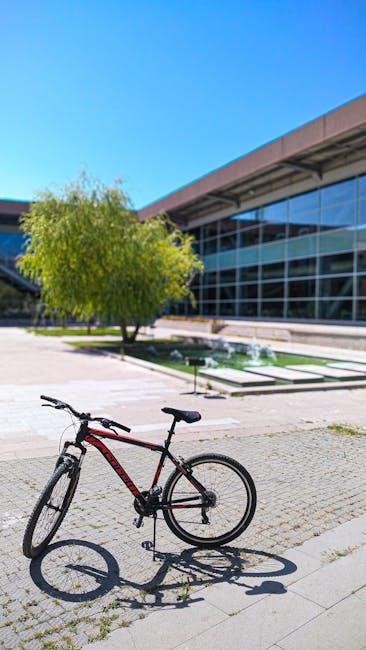Proper bike sizing is essential for comfort‚ efficiency‚ and control. It involves measuring height‚ inseam‚ and body proportions‚ and using size charts or professional fittings to find the perfect fit.
Why Proper Bike Sizing Matters
Proper bike sizing ensures optimal comfort‚ efficiency‚ and control while riding. A bike that fits well reduces the risk of discomfort‚ fatigue‚ and potential injuries. Correct sizing also improves pedaling efficiency and handling‚ making every ride more enjoyable. Additionally‚ a well-fitted bike minimizes strain on the body‚ preventing long-term issues like back pain or wrist discomfort. Proper sizing is crucial for both performance and safety‚ ensuring that riders can maintain control and maneuver confidently. Whether for casual rides or competitive cycling‚ the right size ensures a better overall experience. It’s a foundational aspect of cycling that directly impacts how enjoyable and effective your rides will be.

Overview of Bike Sizing Methods
There are several methods to determine the right bike size‚ each offering unique benefits. The most common approach uses a universal bike size chart based on height and inseam measurements. This method is straightforward but may lack precision for some riders. Another approach involves analyzing frame geometry‚ which provides detailed measurements like standover clearance and reach. Professional bike fittings are also popular‚ offering tailored adjustments for optimal comfort and performance. Additionally‚ some manufacturers provide specific sizing guides for their models‚ considering factors like riding style and body proportions. Each method aims to ensure a proper fit‚ enhancing the cycling experience through comfort and efficiency.

Core Considerations for Bike Sizing

Accurate measurements of height‚ inseam‚ and body proportions are crucial. Understanding frame size charts and standover clearance ensures a safe and comfortable fit for all riders.
Measuring Your Height and Inseam
Measuring your height and inseam is the foundation of proper bike sizing. Stand barefoot against a wall to measure height accurately. For inseam‚ place a book between your legs‚ flush against a wall‚ and measure from the floor to the top of the book. This ensures accurate frame size selection. While height is a general guide‚ inseam provides a clearer indication of standover clearance and optimal bike fit. These measurements help determine the correct frame size and ensure comfort and safety while riding. Always use a tape measure for precise results and consult size charts for accurate fitting.
Understanding Bike Frame Size Charts
Bike frame size charts are tools to help riders select the appropriate frame size based on height and inseam. These charts categorize frame sizes‚ typically in centimeters‚ to match rider measurements. For example‚ a 50-52cm frame suits shorter riders‚ while 55-57cm frames are designed for taller cyclists. While charts provide a general guide‚ they may vary slightly between manufacturers due to differences in frame geometry. Always check the specific chart for the bike model you’re considering. Standover clearance and reach measurements are also crucial for ensuring comfort and safety. Using frame size charts is a practical starting point‚ but test rides and professional fittings are recommended for the best fit.
Importance of Body Proportions

Body proportions‚ such as arm span‚ leg length‚ and torso size‚ significantly impact bike fit. While height and inseam provide a foundation‚ they don’t account for individual variations in limb and body measurements. For instance‚ a rider with a longer torso may need a different stem length or handlebar setup compared to someone with shorter arms. Frame geometry charts often assume average proportions‚ but personal adjustments are crucial for optimal comfort and performance. Ignoring body proportions can lead to discomfort or inefficiency‚ reinforcing the need for test rides or professional fittings to fine-tune the bike to your unique measurements and riding style.
Bike Sizing by Type

Bike sizing varies by type‚ with road‚ mountain‚ gravel‚ and hybrid bikes requiring different frame geometries and wheel sizes to suit their unique riding purposes and terrains.
Road Bike Sizing Guide
A road bike sizing guide helps riders find their ideal frame size based on height and inseam measurements. Most charts align rider height with frame sizes‚ ensuring optimal comfort and performance. For example‚ a rider between 5’1″ and 5’5″ (155-165 cm) typically fits a 50-52cm frame‚ while taller riders may require larger sizes. It’s important to note that slight variations exist between manufacturers‚ so always check specific geometry charts. A test ride is highly recommended to confirm the fit‚ as personal comfort and riding style can influence the best size choice. Use the chart as a starting point‚ but prioritize how the bike feels during a trial ride.
Mountain Bike Sizing Guide
A mountain bike sizing guide helps riders choose the right frame size for off-road adventures. Standover clearance is crucial for maneuverability and safety. Riders typically start with a frame size based on height‚ such as 13-15 inches for shorter riders (5’0″-5’4″) and up to 19-21 inches for taller riders (6’0″ and above). Personal comfort‚ riding style‚ and terrain also influence fit. While size charts provide a starting point‚ test rides are essential to ensure the bike feels right. Adjustments to seat height‚ handlebars‚ and stem can further optimize the fit. Always consult the manufacturer’s geometry chart and consider professional advice for the best match.
Gravel and Hybrid Bike Sizing
Gravel and hybrid bikes blend road and off-road capabilities‚ so sizing varies slightly from road bikes. Riders typically choose frames based on height‚ with sizes ranging from 47cm to 62cm. For example‚ a 5’6″ rider might prefer a 50cm frame‚ while a 6’0″ rider might opt for a 55cm. Standover clearance and reach are key for comfort. Hybrid bikes focus on upright posture‚ so handlebar height and seat position are crucial. Use manufacturer charts as a guide‚ but test rides ensure the best fit. Adjustments to stem length and saddle height can further personalize the bike for optimal performance and comfort.

Specialized Sizing Needs
Specialized sizing focuses on unique rider requirements‚ such as children’s bikes‚ which are sized by age and wheel size‚ and adjustments for body fit‚ including stem length and handlebars.
Kids’ Bike Sizing: Ages and Wheel Sizes
Kids’ bikes are sized by age ranges and wheel sizes rather than frame size. Common wheel sizes include 12″ (ages 2-4)‚ 16″ (ages 4-6)‚ 20″ (ages 6-8)‚ and 24″ (ages 8-12). While age is a starting point‚ height and inseam are more accurate measures. For example‚ a 12″ wheel bike suits children with a 14-18″ inseam‚ while a 24″ wheel bike fits those with a 22-24″ inseam. Always measure the child’s inseam and test ride bikes to ensure proper fit and safety. This ensures comfort‚ control‚ and an enjoyable riding experience for kids.
Adjusting for Body Fit: Stem‚ Handlebars‚ and Seat Height
Proper adjustments to stem length‚ handlebars‚ and seat height are crucial for optimal comfort and control. The stem length should allow a slight bend in the elbows‚ while handlebars should align with shoulder width. Seat height is key for leg extension; knees should have a slight bend at the bottom of the pedal stroke. Standover clearance ensures safe dismounting. These adjustments‚ tailored to body proportions‚ enhance riding efficiency and reduce discomfort or injury risks. Regular fine-tuning‚ especially after initial sizing‚ ensures the best fit for varying riding styles and terrain. Professional fittings can further refine these adjustments for ultimate comfort and performance.
Advanced Sizing Considerations

Advanced sizing involves optimizing frame geometry‚ standover clearance‚ and reach measurements for precise fit‚ ensuring comfort‚ efficiency‚ and control‚ especially for serious riders.
Frame Geometry and Its Impact on Fit
Frame geometry significantly influences bike fit‚ affecting comfort and performance. Key factors include top tube length‚ seat tube angle‚ and head tube angle. A longer top tube improves reach‚ while a steeper seat tube enhances pedaling efficiency. Head tube angle impacts handling‚ with steeper angles offering better responsiveness. Proper geometry ensures optimal weight distribution‚ reducing strain on the back and shoulders. While size charts provide a starting point‚ precise fit requires considering individual proportions and riding style. Advanced riders often benefit from professional bike fittings to fine-tune geometry for maximum comfort and performance.

Standover Clearance and Reach Measurements
Standover clearance and reach are critical for a comfortable‚ efficient ride. Standover clearance ensures there’s enough space between the rider and the top tube‚ typically 1-2 inches‚ to avoid discomfort or injury. Reach measurement‚ the distance from the saddle to the handlebars‚ affects posture and control. Proper reach prevents strain on the neck and shoulders. Handlebar height and stem length also play a role‚ as they influence riding position. For road bikes‚ a more aggressive posture is common‚ while mountain bikes prioritize upright comfort. Accurate measurements ensure optimal fit‚ enhancing both performance and comfort across different bike types and riding styles.
Proper bike sizing ensures comfort‚ efficiency‚ and control. While size charts are helpful‚ test rides and professional fittings provide the best fit for optimal performance and enjoyment.
Final Tips for Choosing the Right Bike Size
Always start with accurate height and inseam measurements to narrow down your options. Use size charts as a guide but consider frame geometry and personal comfort. Road‚ mountain‚ and gravel bikes differ in sizing‚ so choose charts specific to your bike type. Test rides are crucial to ensure the bike feels right. Don’t hesitate to seek professional fittings for precise adjustments. Remember‚ proper sizing enhances performance‚ reduces discomfort‚ and prevents injuries. Combine these tips with manufacturer recommendations for the best fit tailored to your needs and riding style.
Importance of Test Rides and Professional Fittings
A test ride is crucial to ensure a bike feels right‚ as static measurements don’t always capture real-world comfort. Professional fittings fine-tune stem length‚ handlebar height‚ and saddle position‚ maximizing efficiency and reducing strain. Experts use precise tools to tailor the bike to your body‚ improving performance and reducing injury risk. Even with accurate size charts‚ personal anatomy and riding style can affect fit. Prioritize test rides and consider professional guidance for optimal comfort and performance. These steps ensure your bike is perfectly suited to you‚ enhancing every ride’s enjoyment and effectiveness.



